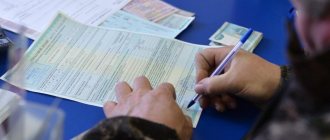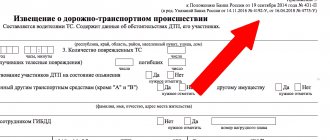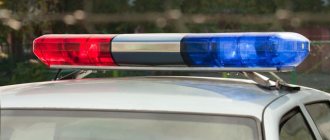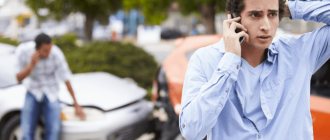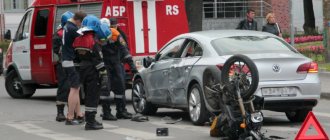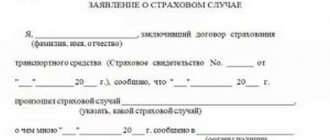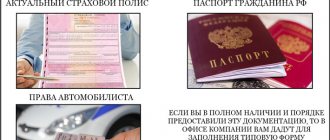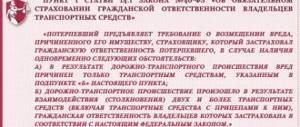If the culprit of an accident is not identified , despite all the measures taken by the police, drivers have problems. Who will compensate for the damage to the car?
In some cases, paying out insurance under compulsory motor liability insurance will help. Having a CASCO policy will significantly simplify the solution to the problem. However, in most cases, car owners are forced to restore their vehicles themselves.
Be that as it may, you need to have an idea of how a driver’s involvement in an accident is established. After all, the second participant in the incident may insist on his innocence, and then it will have to be proven in court.
How to file an accident without insurance?
If an accident occurs and the damage is minor, then the first thing you want to do is to do without calling the traffic police and draw up a European protocol.
STOP! Before filling out a European protocol, make sure that the person at fault for the accident has insurance. If there is no insurance, the European protocol cannot be issued.
In case of an accident without insurance, it is necessary to either agree on the spot, when the damage will be immediately compensated for those responsible for the accident, or call traffic police officers. The procedure will be as follows:
- Vehicles must remain in the same position as they were at the time of the accident.
- Put up emergency stop signs
- Take photographs of the accident scene and also make video recordings of the accident scene
- Call the traffic police to fill out a report. When drawing up a report, traffic police officers will have to indicate that the person at fault for the accident does not have insurance.
- If the culprit fled the accident without insurance, still remain at the scene until the traffic police arrives.
Thus, in case of an accident without insurance, documents must be completed by traffic police officers.
Procedure in case of an accident in 2021
A person involved in an accident begins to feverishly think about what to do and what actions to take. There is no need to waste time on phone calls to friends, relatives and acquaintances. The best assistant is the emotionless state of drivers and passengers. You should be extremely focused, focused and concentrated. This is the best advice regarding the internal mental state.
No driver is insured against an accident, even if you strictly follow the traffic rules
What to do in case of an accident without injuries?
Let's consider the most favorable outcome - an accident without injuries. First of all, the alarm system turns on and an emergency sign is displayed. In the dark, wear a reflective vest.
After a minor accident with little damage has occurred, you can proceed in several ways with or without the involvement of traffic police officers. If inspectors are called, the wait will take three or more hours.
A single emergency number 112, which you can call for free on a mobile phone even if your SIM card is missing or blocked . The request is immediately transmitted to the appropriate authorities. The standard call to the police via cell phone is 102.
As a rule, representatives of the inspection are called in controversial situations when drivers have failed to reach an agreement. There is no agreed position on how to pay for the damage. The police interview each driver, receive explanations, and draw up a report.
Each driver is free to present his own version. If one of the participants does not agree with the statement of the opposing party, explanations, reasoned comments, facts about the case and conclusions are sent to the inspectorate.
If possible, photographs and video materials and an express interview of another participant are provided. In case of legal proceedings, the collected documents are transferred to the human rights body as evidence to support their position.
What to do without calling the traffic police:
- Agree and part ways. A driver who voluntarily pleads guilty pays damages on the spot, in agreement with the other participant. Damage is assessed based on a purely subjective opinion with a small additional payment for any inconvenience caused. They exchange receipts, which each driver representing one side or another receives;
- Drawing up a European protocol. The document is drawn up if each participant has an MTPL policy. All points of the form are filled out indicating the time and place of the incident. The signature of both drivers is affixed.
Actions are coordinated in the manner prescribed by the traffic rules. Namely, independent recording of the position of cars during a collision and the resulting damage. But the traffic regulations do not specify what drivers should do if they do not have photo and video recording equipment at hand.
In any case, the law requires that cars be removed from the scene as quickly as possible. Otherwise, the same rules impose sanctions in the amount of 1,000 rubles from each driver, who leave the car for a long time after the accident and the formal procedures for establishing damage when agreeing and compensating for damage.
Drivers are often able to deal with minor incidents on their own. The MTPL policy protects against motor vehicle liability, and the traffic police are involved in exceptional cases.
What to do in case of an accident with injured or dead people?
The worst option is an accident with victims, where a lot depends on the actions and composure of the driver. There are clearly defined regulations in the rules.
Prioritization:
- The object of primary importance is the provision of medical care to the victim. You must call emergency medical assistance using the single number 112 or 103;
- Before the arrival of traffic police officers, who are called after medical assistance, the driver needs to look around, write down possible eyewitnesses;
- Take the contact details of witnesses and ask them to wait for the traffic police. In especially serious cases, it is necessary to wait for the investigator or investigative team;
- Use a video recorder or phone to try to record traces of the incident. Take photos and videos, look at the braking distance;
- In case of an accident with pedestrians, the direction of movement of the victims and moving vehicles is recorded;
- Remove damage to your car, traces, integrity or damage to wheels and the location of vehicles;
- Pay attention to whether there are holes, potholes, signs, markings on the roads, and record the operation of the traffic light.
The point is to witness as many objects as possible that will help in the further investigation of the case. The fall of soil clearly characterizes the scene of the incident. Oil and brake fluid spills are all traces that are an integral part and are subject to investigation when determining who is at fault for the incident.
What is the Europrotocol?
If the damage is minor, you can agree to register the accident under the European protocol, which has been in force in Russia since 2009. Based on the nature of the damage, the loss is estimated at no more than 50,000 rubles. There must be a mandatory consent of the two participants about the violation of traffic rules by one of the parties. The first step is to check the offender’s documents and the current MTPL insurance policy.
How to make sure the policy is legal:
- The document must contain watermarks;
- A metal tape (hologram) is detected in the light;
- The imprints of the numbers are checked by touch with your fingers. Volume should be felt;
- According to Civil Law, a contract is concluded by two parties: the policyholder and the insurer. Participants must be enrolled in the policy.
The European protocol is drawn up only by the participants in the accident themselves. When concluding a compulsory motor liability insurance agreement, a notice-memo for filling out is attached. It specifically describes how the protocol is filled out. Each agent issues complete instructions for use and the protocol itself. Mandatory condition: the document must be made on self-copying paper with printed sheets.
Participants in an accident can agree on their own and fill out a European protocol
Calling the emergency commissioner
An emergency commissioner is sometimes called to the scene of an accident as an alternative to the traffic police. An emergency commissioner is an expert from an insurance company or an employee of an outsourcing company with which the insurance company enters into an agreement for the provision of emergency commissioner services.
Responsibilities include:
- Departure to the scene of an accident at the customer’s address or location;
- Drawing up a road accident diagram;
- Assessment of damage caused to the vehicle;
- Conducting consultations on what needs to be done to restore the car and bring it into proper condition;
- Preparation of necessary documents for vehicle repairs;
- Protection of rights in insurance companies, traffic police and in court.
Some insurance companies require photos or videos of damage. To identify and confirm the make and model of the vehicle, four diagonal photographs are taken from all angles. Next, a detailed survey takes place: what is damaged, what parts, and the nature of the damage is described.
The procedure is necessary so that the expert of the insurance company, to which the commissioner submits the report, makes a decision on repairs or payment of funds for the repair of equipment.
A set of documents is being compiled:
- Application from the insured driver or an authorized representative;
- Documents for the car;
- Damage inspection report. The make, model, equipment, type of body damage, recommendations for vehicle restoration are indicated;
- An inventory of the documents provided for registration of the insured event is made.
The driver can, on his own initiative, call the emergency response team when help is needed. One-time services are provided or an annual subscription for ongoing service is purchased. The accident commissioner will become an assistant to the driver who was involved in the accident.
The accident commissioner will competently draw up legal papers and independently transfer them to the insurance company
Calling a traffic police officer
The incident is first reported to the duty station. The duty officer directs the outfit. Before the inspector arrives, the picture of the accident must, if possible, be recorded in its original form, without touching anything: scattered fragments, bumper marks, soil debris.
For the driver, this may be an insignificant item, but for the investigative team, the untouched items will become important evidence that can further prove innocence. After filming, if the accident is not significant, the vehicle is removed from the roadway so as not to interfere with traffic.
Before drawing up an accident diagram, you need to look around, find out the nearest address, and check the time of the incident with other participants. Instead of a ruler, you can use a driver's license or vehicle certificate.
The diagram shows:
- The roadway indicating road markings and additional ones, if any;
- The location of vehicles before and after the moment of collision;
- The triangle indicates the front of the car;
- Numbers or letters indicate vehicles and the direction of travel before the collision;
- The location and area of the collision are indicated, indicating the streets, nearest building or house;
- At the top of the diagram the address, date and time of the accident are signed;
- At the bottom, the contact details of the participants, driver's license numbers, license plates and brands of cars, addresses, telephone numbers, names of eyewitnesses, symbols are recorded;
- Participants and eyewitnesses must put their signatures on the diagram.
The participant in the accident is given:
- Road accident diagram;
- Protocol-resolution regarding the culprit or a ruling on the refusal to initiate proceedings on an administrative offense;
- A certificate of an accident, which the employee makes on the spot. Information about the driver, vehicle, vehicle owners and insurance company data are provided.
If disagreements arise and the driver does not agree with the conclusions, there is a “Comments” column at the end of the form, where all objections must be written down. Employees' actions are allowed to be filmed on the phone. The very fact of turning on the phone forces the traffic police to record objective data in the protocol.
In an accident with injuries or deaths, the case is administrative or criminal in nature. The participant in the accident has the right to invite a qualified lawyer to the scene of the accident. From little things, expressed in seconds, the guilt or innocence of the driver is then born.
If the participants in an accident have disagreements, then you must call the traffic police by calling 102
Claim to the culprit of an accident who did not take out or expired compulsory motor liability insurance policy
If the person at fault for the accident did not have insurance under compulsory motor liability insurance, then the injured person will have to recover damages from the accident directly from the person at fault.
Before going to court, it is necessary to send a claim to the guilty person demanding payment of the amount of damage, and the damage must somehow be justified by the injured party, namely, either by an expert’s opinion, by the person with an assessment report, etc.
The injured person may have a CASCO agreement, i.e., when the insurance company compensates the person for the damage caused to his property. The relevant contract may provide for the period and method of notification of the occurrence of an insured event. If the victim has provided his insurance company with all the necessary documents to compensate him for the damage, but the insurance company refuses, then it may be necessary to go to court. Before going to court, in addition to an application for payment of compensation, you should also send a claim that payment is not being made, with a request to make payment. In addition, you must write a complaint to the financial ombudsman.
When insuring under CASCO, as well as under MTPL, there are some nuances regarding the amount of compensation. There may be a situation where the amount of damage exceeds the amount of compensation, then the remaining amount will have to be recovered from the guilty party; accordingly, the claim must be sent to both the person responsible for the accident and the insurance company.
USEFUL : our lawyer will help you make a claim correctly, watch the video
Who is guilty?
As practice shows, the most problems in a traffic accident arise when determining who is to blame for this incident. Sometimes the parties argue for a long time. If you are involved in an accident, after which it is not clear who caused it, then there is only one way - to court.
If the parties cannot come to a general agreement, then registering an accident using the Europrotocol is impossible. You definitely need to call the traffic police. And this will be the first authority that will have to sort out the current situation. By the way, if one of the drivers does not have compulsory motor liability insurance, then both will probably be at fault, and no one will receive compensation.
The traffic police inspector records all the details of the incident on the spot, drawing up a protocol and a certificate of the accident along the way. Help can be regular or extended. In case of a minor incident, a regular certificate is issued, which describes all the details.
If you are involved in a serious accident in which there are injuries, and one of the drivers raises suspicions of drunk driving, then an extended document will be drawn up here, where data on the medical examination will be entered.
The medical examination that drivers at fault in an accident usually undergo must follow all the rules of the procedure:
- the procedure must be carried out in medical institutions licensed for this;
- the examination must be carried out by a narcologist or toxicologist;
- the driver has the right to refuse this procedure, but this is a reason for refusal of payments;
- The medical examination report is an important document and is drawn up in triplicate, one of which is attached to the package of documents for the insurance company.
In some cases, an emergency commissioner may work at the scene of a disaster; he is not included in the MTPL service package, but his services are included in CASCO insurance. This is usually an employee of the insurance company acting in the interests of his employer.
Sometimes the avarcom may be from a private company, and then he considers the amount in the interests of the victim. But the most fair way to determine the amount of damage is an independent examination.
Today, according to the law, an independent examination of a car after an accident can only be carried out by a company or expert accredited for this type of activity. A car technical inspection can determine not only the amount of damage, but also provide evidence of guilt or innocence of the driver of the vehicle being examined.
All data from the traffic police, emergency commissioners, and independent experts will need to be submitted to the court. This should be done as soon as possible after the accident, since the insurance company will not begin paying until the culprit is identified.
How to file a claim against the culprit of a traffic accident without a policy?
A claim against the culprit of an accident who did not have insurance when the corresponding event occurred is filed according to the general rules of procedural legislation, indicating the following information:
- name of the court that will hear the filed claim
- Full name or name of the plaintiff, his address, as well as, if available, telephone number, email address. mail
- information about the defendant, i.e. Full name, address, and also, if known, date and place of birth, place of work and one of the identifiers (TIN, SNILS, etc.)
- title of the document – statement of claim
- the content of the claim sets out the circumstances of the accident, i.e., when, where, between whom the accident occurred, who is the culprit and how this is confirmed, the motivation for the claimed claims, for example, for compensation for damage caused with reference to evidence, which also confirms size of requirements
- the operative part of the claim formulates specific claims that the plaintiff asks the court to satisfy
- the list of appendices of documents to the claim indicates the corresponding attached evidence
- at the end, the claim must be signed by the plaintiff, the transcript of the signature and the date of drawing up the claim should also be indicated
USEFUL : order a lawsuit from our lawyer, watch the video on the topic
What does OSAGO insure and what does it not?
An OSAGO insurance policy is a mandatory contract that must be concluded by every car owner, regardless of his desires and budget. The amount of the insurance premium (policy cost), as well as the maximum insured amount (insurance payments) is regulated by the laws of the Russian Federation.
OSAGO protects vehicle owners from having to pay for damage caused to another car as a result of an accident for which they are at fault. The culprit does not receive any compensation if he only has a mandatory auto insurance policy, but if he has full CASCO insurance, the payment, of course, will be.
Before you decide to apply for damages from an insurance company, you should make sure that you actually have an insured event.
There will be no payments under compulsory motor liability insurance if:
- there was damage caused by another vehicle not specified in the contract;
- moral damage was caused or there was a need to compensate for lost profits;
- the damage was caused as a result of competitions, tests or training riding;
- the vehicle caused harm to health through the cargo it was transporting;
- there was harm to the life or health of employees during the performance of their official duties;
- the driver caused damage to the vehicle or trailer, cargo, as well as equipment he was driving;
- damage was caused while loading cargo onto the vehicle or unloading it;
- damage was caused to antique objects, buildings, structures of historical and cultural significance, products made of precious alloys, stones, cash, shares, religious objects, works of intellectual work;
- the accident involved not two, but several cars;
- the driver committed an accident while intoxicated, or took alcohol before a medical examination, or there was clear intent in his actions;
- there are force majeure circumstances - force majeure.
How to win a case in a car accident without insurance?
In order to win a lawsuit for an accident without insurance, you must first take care of the evidence base, that is, collect all the necessary documents to prove that you are right. In addition, in some cases, expert opinion is required.
If the plaintiff decides not to provide part of the evidence, for example, not to contact experts ahead of time, so as not to spend extra money, then during the consideration of the case and if there are objections from the plaintiff, you can petition the court to appoint an expert examination to determine, for example, the size harm caused.
You should carefully consider the arguments of the opposing party, who objects to the stated requirements, and provide counter-arguments to their arguments.
Judicial practice will also help in resolving the dispute in favor of the plaintiff, as well as various decisions of the plenums, which should be referred to either in the claim, or in additions to the claim or explanations, which are best prepared in writing and submitted to the court.
Depending on the circumstances of the accident, you can file a motion to question witnesses, if any.
Active behavior during the consideration of the case, i.e. explanations on the circumstances of the case, on the merits of the stated requirements, and objections to the arguments of the second party together will help to win victories. However, it should be borne in mind that the requirements must be legal and supported by documents.
Receiving payment under compulsory motor liability insurance
After you have submitted an application to the insurance company, you can only wait to receive payments. They must be transferred to you within 20 calendar days:
4. The professional association of insurers considers the victim’s application for compensation payment and the documents attached to it within 20 calendar days, excluding non-working holidays, from the date of their receipt. During the specified period, the professional association of insurers is obliged to make a compensation payment to the victim by transferring the amount of the compensation payment to the victim’s bank account or sending him a reasoned refusal to make such a payment.
The money will be transferred to the account you specify when submitting your application.
If the amount received does not suit you, then you can conduct an independent examination and go to court for additional payments.
Good luck on the roads!
No one can protect themselves from getting into an accident. You can know and follow the rules of the road so as not to become the culprit of an accident, but the fact of getting into it as a passenger in a vehicle or even as a pedestrian cannot be ruled out.
Mandatory and optional motorist insurance policies are designed to regulate the financial relationship between the parties to the accident.
Motor vehicle and comprehensive automobile insurance are provided for drivers, because it is because of their actions that accidents occur most often.
In this article we will tell you about the procedure for victims of an accident, if the participants have compulsory motor liability insurance and/or CASCO insurance, or if there is no any type of insurance, what to do after an accident as an injured driver, passenger or pedestrian.
The information provided will be useful for everyone, as it will help to quickly understand the algorithm of correct actions so as not to aggravate the consequences of what happened on the road.
What to do if the person at fault for the accident has no money?
The question of what to do if the culprit of an accident does not have money can arise both at the time of the accident and after the court makes a decision to collect funds from the culprit.
If the person at fault for the accident does not have money, but has insurance under compulsory motor liability insurance, then the insurance company must compensate for the damage in a certain amount.
If at the time of the accident the culprit has no insurance and no money, then in any case it is necessary to draw up all the documents regarding the accident, and then decide whether it makes sense to go to court with a claim against the culprit or not.
If a claim is filed for recovery of damage caused and the court makes a decision in favor of the plaintiff, then bailiffs must get involved and carry out actions to forcibly collect funds from the debtor. If the debtor does not have money, then measures must be taken to search for his property with a view to seizing it and selling it at auction.
And yet, if the debtor has nothing at all, lives with relatives, does not work, and the car was not his at the time of the accident, then there is little chance of recovering anything from him. In such a situation, one can only hope that someday the debtor will have something and then the bailiffs will be able to describe the property or seize accounts and satisfy at least partially the demands of the collector.
Contacting an insurance company for compulsory motor liability insurance
Before going to the insurance company to file a claim, I recommend calling them. The fact is that, firstly, you cannot submit an application at any office, and, secondly, not at any time (there must be an employee on site assessing the damage).
You will need to fill out an application with the insurance company, wait for the damage to the vehicle to be assessed and sign the corresponding document. In principle, nothing complicated, but in practice the whole procedure can take 2-3 hours of your time.
One more note. You need to go to the insurance company confident that you are right.
When I contacted the insurance company for payments, the employees said the following:
1. The notice was filled out with one hand, so you should not count on payments.
It is quite natural that the victim filled out the notice on his own. The culprit may intentionally make mistakes in order to avoid payments.
2. The copy of the notice does not say anywhere that the culprit admitted his own guilt.
This is also quite logical, because this copy of the notice is filled out by the victim. Applications and documents? There are no fields reserved for the culprit. In addition, drivers are not generally required to independently determine the culprit of an accident. They only need to agree on the circumstances of the accident and the list of damages.
In general, if they tell you something like that, don’t be alarmed. The listed features of the notification do not affect the fact of payments.
Before giving the signed documents to the insurance officer, I recommend photographing them. Firstly, later you will be able to see what the insurance company wrote. Secondly, you will have evidence that you submitted documents to the insurance company at all.
Direct settlement and the European Protocol
Today, there is a simplified scheme for calculating payments under compulsory motor liability insurance. There are a lot of positive aspects in it. So, for example, in the case of a minor accident, a person can immediately after completing the Euro Protocol go to the insurance company and submit an application for compensation.
The possibility of drawing up a Europrotocol exists based on a combination of factors:
- the damage was caused only to cars, there is no harm to the health of the victim, and its amount does not exceed 100 thousand rubles;
- Only 2 cars were involved in the accident;
- both drivers have MTPL policies;
- drivers have no difference of opinion regarding the causes of the accident, the culprit admits his guilt.
Under these circumstances, participants can fill out the Europrotocol - a form that is issued with the MTPL policy when signing the contract. And from September 1, 2021, if you have registration on the government services portal, the mobile application “OSAGO Assistant” and an electronic signature, this document can be issued online. However, for about a year, only residents of Moscow, St. Petersburg and their regions will be able to use the new service. After registering an accident, the participants can leave, and the victim can go straight to the insurers and apply for direct compensation for damage.
You can also receive payments from the insurance company of the culprit. In this case, you need to contact the insurer who is indicated in the protocol in the column that the culprit filled out. There should be:
- name of the insurance company;
- address and telephone;
- series and number of the MTPL insurance policy.
Payment can be made in the following ways:
- cash;
- transfer to a bank account;
- restoration repairs at a partner service station.
I would like to immediately make a reservation that the last method is the most unreliable, since the insurance company can easily reduce the cost of restoring your car, and you will not be able to control what parts are put there. Therefore, when signing an MTPL agreement, insist that the payment method be indicated clearly and without alternatives.

